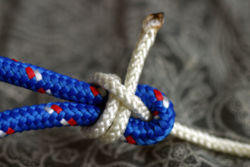Difference between revisions of "Translations:AY Honors/Knot/Double sheet bend/2/es"
From Pathfinder Wiki
(Created page with "</noinclude> {{Knot/es | name=Vuelta de Escota Doble | image= Double sheet bend.jpg | use= La '''vuelta de escota doble''' es un nudo fuerte usado para atar dos cuerdas (gene...") |
|||
| Line 1: | Line 1: | ||
</noinclude> | </noinclude> | ||
{{Knot/es | {{Knot/es | ||
| − | | name=Vuelta de | + | | name=Vuelta de escota doble |
| image= Double sheet bend.jpg | | image= Double sheet bend.jpg | ||
| use= | | use= | ||
Revision as of 18:54, 20 January 2019
| Vuelta de escota doble |
|---|
|
Uso: La vuelta de escota doble es un nudo fuerte usado para atar dos cuerdas (generalmente de diferentes grosores o rigidez) juntas. Es una versión duplicada de la vuelta de escota.
Cómo amarrar:
ADVERTENCIA: Como con la curva estándar de la vuelta de escota, los dos extremos deben terminar en el mismo lado del nudo. Si no lo hacen, una vuelta de escota zurda resulta, que es mucho más débil.
|

